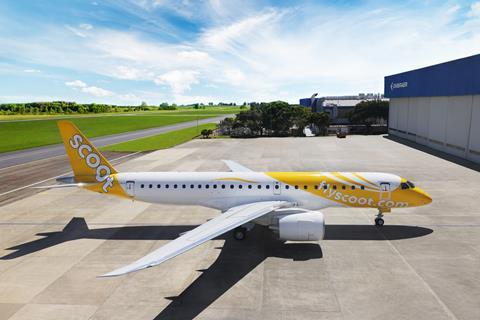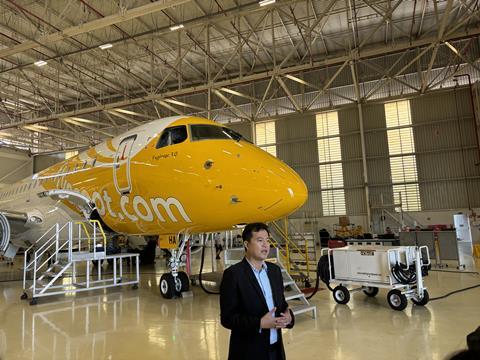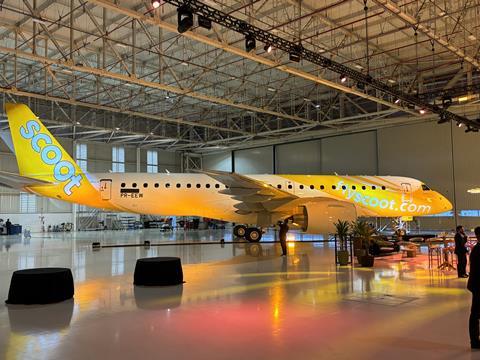While the delivery of Scoot’s first Embraer 190-E2 is a major milestone for the low-cost operator and its parent Singapore Airlines Group, it holds deeper significance for the Brazilian airframer, which for years has been trying to make inroads into the Asian market.
Scoot on 12 April took delivery of the first of nine E190-E2s (9V-THA), making it the type’s first operator in the Asia-Pacific.

Not since the late 1990s has the airline group, which also comprises mainline operator SIA, operated an aircraft type not supplied by Boeing or Airbus. The E2, which will enter commercial service in May, is also the group’s smallest aircraft, with 112 seats in a single-class configuration.
Scoot’s order announcement was a surprise deal viewed largely as a win for Embraer, which then went on to pick up a second order for 10 E195-E2s from Malaysian operator SKS Airways a few months later.
As expected, the Brazilian airframer is bullish about the opportunities following Scoot’s E2 debut, and expects to net fresh orders for the twinjet this year.
‘MARQUEE CUSTOMER’
FlightGlobal was invited to a two-day media trip in the lead up to the delivery ceremony at Embraer’s Sao Jose dos Campos headquarters, where Scoot executives – including airline chief Leslie Thng and operations chief Ng Chee Keong – were also present.
Thng acknowledges that while Embraer was a “largely unknown entity” to Scoot, the airline was ultimately won over by the “commercial terms” and “operational support” promised by the Brazilian airframer.
Indeed, through the media visit, it was evident the two parties have cozied up well: Embraer executives were glowing in their descriptions of their newest customer, describing the airline a “role model”, a “marquee customer” and “tough but thorough”.

At the aircraft handover ceremony, Embraer commercial airplanes chief Arjan Meijer said the airframer was proud to add Scoot to its customer base.
Scoot announced its order for nine E2s in February 2023, taking them on lease from lessor Azorra, which the airline has also not worked with before.
As Thng, who was making his first-ever trip to Brazil, noted: “It’s just a matter of getting to understand each other better.
“We are not the first operator of the E2…[and] when we look at some of the operating statistics in the market, it is an aircraft [that] will be able to deliver operational reliability [and] operational resilience. This regional jet, we think, is perfect for us in terms of complementing our overall network strategy.”
He had previously told FlightGlobal in 2023 it saw a “business case” to have a third aircraft type in its fleet, citing “additional growth opportunities” through network expansion, as well as increased connectivity.
MAKING THE E2 WORK
Thng says the airline will have until 2026 to fully evaluate the E2’s performance in the fleet. By then, the airline would have a “clearer idea” of the future of the aircraft type.
“If it is successful, I think it will give us a lot of food for thought to see how we can further expand the fleet. If it’s not so successful, then we will have to think how we can minimise [our] exposure on the fleet we currently have,” says Thng, who stresses that the low-cost operator is “quite confident” that the E2’s service “will turn out quite well”.
The airline says it is “committed” to see its E2 operations succeed both financially and operationally. To buffer against potential issues with the jet’s Pratt & Whitney PW1900G engines Thng says the airline has invested in spare engines.
It is also deploying its initial pair of E2s to right-size existing routes, such as adding more frequencies to cities like Hat Yai and Krabi, and expanding its network with two new cities: Samui in Thailand and Sibu in Malaysia.
Already the signs are positive: Thng says the forward bookings on the two new routes were within expectations, noting that Samui demand came mainly from international transit passengers, while forward bookings for Sibu “are also building up quite strongly”.
The airline will announce three to four new points within Southeast Asia when it takes delivery of its next few E2s during the rest of the year.
As for now, Scoot is working to prepare for the E2’s service entry. With the first example already in Singapore, work is underway with national regulators to have certificates of airworthiness and registration issued, paving the way for eventual commercial operations.
“We have made plans in the overall [entry-into-service] timetable to make sure we have enough time to understand [the E2]…and what we have achieved so far…has been according to our plan,” says Thng.
‘WE SEE THE MARKET IN OUR HANDS’
Thng adds that the trip to Brazil was ”beneficial” not just for the aircraft delivery, but also to “better understand the processes…and [get a] better sense of the kind of support they would be giving Scoot”.

In the lead-up to the first E2’s delivery, Embraer worked with Scoot to secure type certification for the E190-E2 in Singapore, and months later announced the opening of a full-flight simulator and cabin crew training facility in Singapore.
Says Embraer vice-president for Asia-Pacific Raul Villaron: “Because Scoot doesn’t have a domestic market, they will fly [the E2] to neighboring countries, and the airlines in those countries will see the aircraft. The passengers in those countries will fly that aircraft. Scoot and Embraer are also building a support infrastructure that wasn’t there [before].”
The visibility of the E2 within Southeast Asia – coupled with a more accessible training support – “makes it easier” for prospective customers to decide to take the type.
Thng himself is aware of the role Scoot plays as the E2’s de-facto ambassador in the region: “I think it’s a win-win solution for Embraer and ourselves. As we start to fly to more destinations in Southeast Asia the awareness of the Embraer brand will be reinforced within the region.”
Indeed, Villaron believes the imminent service entry will be closely watched by other operators in Southeast Asia.
While Australia and Japan remain two of Embraer’s “backbone” markets, Villaron believes new opportunities can be found.
Vietnam, for instance, has had Embraer operations with Bamboo Airways, with the type helping to connect island cities with the mainland.
While Bamboo Airways has suspended regional jet operations amid financial struggles, Villaron says the country’s two largest carriers – Vietnam Airlines and Vietjet – “recognise there is a market” for regional aircraft.
He also cites Samui, the island airport in Thailand which Scoot will deploy its E2s to, as another example of market potential. Bangkok Airways operates a mix of turboprops and Airbus A319s from Samui, given the operational limitations at the airport.
Indeed, Villaron says the airframer took “a leap of faith” in Southeast Asia, because “we believe there is a much bigger market out there”. He expects two or three new customers in Asia to be announced this year.
He acknowledges that the airframer had been “struggling” in a region dominated by low-cost operators preferring lower seat costs that the earlier generation of E-Jets could not match.
But the pandemic “has changed the way people fly”, notes Villaron, with airlines like Scoot “now seeing the benefits of a flexible fleet” not just to cater to changing demand, but also to manage wider supply chain uncertainty.
This presents the airframer with opportunities in Asia, and Scoot’s imminent service entry of the E2 will further boost its chances.
“The market is now in our hands – we can feel it!” says Villaron.



























